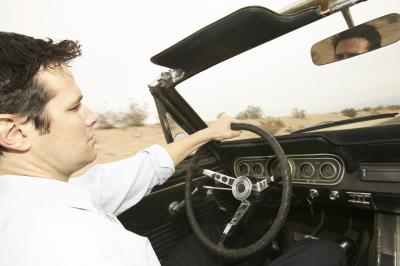
A rack and pinion is a type of actuator that translates rotational movement into side-to-side movement. It consists of a circular gear, the pinion, that meshes with a flat-toothed bar, and the rack; when the pinion turns, it engages with the rack and moves it horizontally. Used more than 200 years ago as a means of locomotion, rack and pinion systems are now commonly used as a steering mechanism in automobiles and other vehicles.
In 1811, English engineer John Blenkinsop invented a system that would increase the traction of lightweight railroad locomotives. In Blenkinsop's system, the steam engine drove a geared wheel that engaged a geared rail on one side of the track. This rack and pinion system pulled the engine along the track, allowing it to more efficiently transmit its power to the rails and move up steep inclines. The system worked well, and the basic design is still in use on modern cog railways.
European auto manufacturers began to use rack and pinion steering systems, in which the pinion is turned by the action of the steering wheel and the car's wheels are moved by the corresponding movement of the rack, in the 1930s. These systems replaced recirculating-ball steering systems, which are more complex than rack and pinion systems and more expensive to build. American automakers were slow to adopt rack and pinion steering technology, and the first American production cars to use the systems, the Ford Mustang II and Pinto, debuted in 1974.
A shortcoming of basic rack and pinion steering is that it tends to be overly sensitive when used at high speeds, causing small steering inputs to result in potentially dangerous movements of the wheels. In 1973, Australian engineer Arthur E. Bishop patented a variable ratio rack and pinion system that attempted to solve this problem. Bishop's system uses a rack with varied tooth spacing along its length, with closely spaced teeth at the ends and more widely spaced teeth near the center. The effect is that movement of the steering wheel causes relatively little movement of the wheels at the beginning of a turn and more movement of the wheels as the steering wheel is moved further.
Moving a car's wheels with a basic mechanical system can be difficult, and since rack and pinion mechanisms provide less mechanical advantage than systems such as a recirculating-ball mechanism, they require even more effort to operate. By the 1960s, American automakers offered power-assisted steering as an option or standard equipment on most of their models. Power steering systems use a hydraulic cylinder to help move the rack, and the cylinder is actuated by input from the steering wheel. Early power steering systems suffered from oversensitivity at high speeds, and in the 1980s manufacturers developed electronic control systems that limited power assist as the vehicle's speed increased.